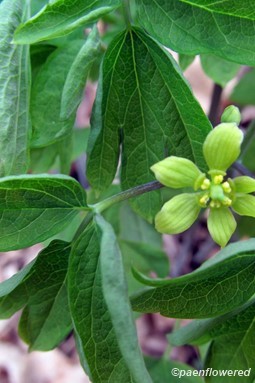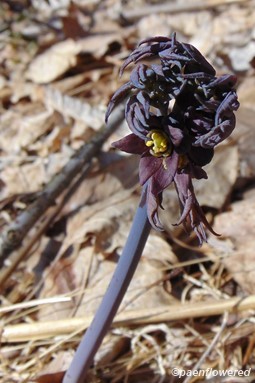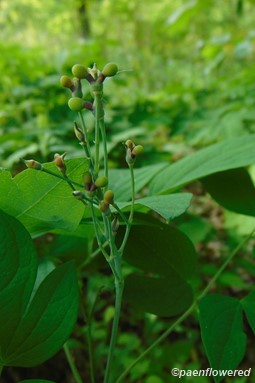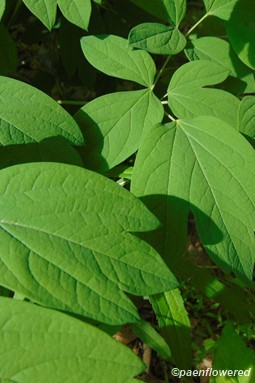Caulophyllum thalictroides
A woodland plant with bluish leavs and yellow inconspicuous flowers
Caulophyllum thalictroides blue cohosh
The flowers of this interesting plant are not showy and blend into the forest background to such a degree that it often takes a sharp eye just to see them. It is a perennial member of the barberry family that grows 1-3 feet high in moist hardwood forests of the eastern United States. In the South it is limited to the mountains. It is found in most counties of the state.
In spite of its lack of bright coloration, it is still an interesting wildflower. The flowers are about ¼ to ½ inch in diameter and greenish-yellow in color. I have also seen the flower in a dark brown/maroon color or in an intermediate shade. Apparently, these variations are considered the same species. The flowers have 6 tiny petals, each with 2 glandular nectar glands. These petals grow from the base of 6 larger petal-like sepals. There is a central pistil and six stamens. Under each flower are 3-4 small green bracts that resemble sepals. The flowers occur in clusters of 5-20 but mature at different times, encouraging cross-pollination by early solitary bees. The flowers produce both pollen and nectar as a reward to the insects.
After pollination the ovary forms a capsule that bursts opens to expose 1-2 deep blue fleshy seeds that resemble berries - perhaps another reason for the common name. This rupturing of the ovary is an unusual process for flowering plants. The seeds are toxic to humans, but birds and small mammals will feed on them and help with dispersal. The blue cohosh flower blooms in April or May in Pennsylvania. The plant prefers shady locations.
There is one true large compound leaf per flowering plant, but the proliferation of tulip-shaped leaflets makes it look as if there are more. The one leaf develops further into 3 compound leaves on separate stalks. The often bluish-green color of the leaves contributes to the common name of this species. Each leaflet is 1.5-3 inches long. The leaflets somewhat resemble those of the meadow rue.
Young plants are covered with a waxy bloom. The seeds may have been used as a coffee substitute in the past. Extracts of the roots have been used as an herbal medicine, but as in all cases, should be used with great caution, if at all.
Habitat & Range
Grows in moist hardwood forests. Prefers shade.
Present in most counties of the state.
Range: New Brunswick and Ontario to Manitoba, south to South Carolina, Tennessee, and Missouri.
Wetland code: Not classified
Phenology
Flowers April to early May.
Characteristics
Infloresence terminal, panicle-like cyme
Flowers greenish-yellow or greenish-purple, ¼ to ½″; 6 sepals subtended by 3 to 4 sepal-like bracts, 6 stamens
Leaves ternately compound (1 tri-ternately compound leaf); leaflets dark bluish-green, obovate-oblong, lobed above middle; 2-3″
Stems erect, glacuous
Fruit blue, berry-like fleshy-coated seeds
Rhizome knotty and branching
Height 1 to 3 feet
Identification Tips
One large unfolding compoun leaf appears in early spring.
Plant Codes
S-rank: S5 (Secure)
G-rank: G5 (Secure)
Medicinal Qualities
Roots are used to treat rheumatism and bronchitis.
Ecology
Woodland birds and small mammals such as mice feed on the berries and help with seed dispersal. Leaves are generally avoided by mammals due their toxicity.










Comments
Have you spotted this plant in your area? We'd love to hear about your experience! Share your comments or questions about the plant below. Comments are moderated before posting.